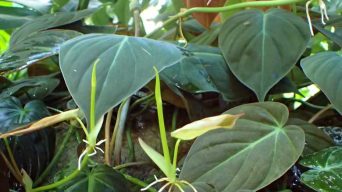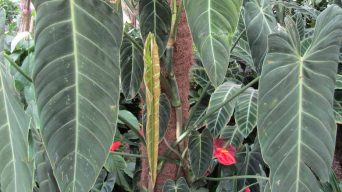Growing Philodendron verrucosum can be easy and rewarding, as this plant is beautiful and versatile.
It can be used as a houseplant or outdoors in shady areas.
Philodendron verrucosum care is not difficult, but there are a few things to know to keep your plant healthy.
With the proper care, it will thrive and produce stunning foliage.
Here is a complete guide to growing and caring for the Philodendron verrucosum.
Overview
Philodendron verrucosum, also known as Ecuador Philodendron, is species of flowering plant in the family Araceae native to South America.
It is a climbing plant with large, glossy leaves.
It produces aerial roots that it uses to attach itself to trees or other structures.
The plant can grow up to 3 feet tall.
The leaves are heart-shaped and can grow up to 18 inches long and 12 inches wide.
The flowers are small, borne on an inflorescence up to 3 feet long.
The plant is often used as an ornamental plant in gardens, or as a houseplant
Philodendron verrucosum is a tropical plant that prefers warm, humid conditions.
It is an easy plant to care for and can be grown indoors or outdoors.
There are several varieties of Philodendron verrucosum, including:
- Philodendron Verrucosum Incensi
- Philodendron Verrucosum Panther
- Philodendron Ecuadorian Canoe
- Philodendron Verrucosum Red Back
- Philodendron Splendid
How To Care for Philodendron Verrucosum (Ecuador Philodendron)
Philodendron verrucosum care is not difficult, although this tropical plant has some particularities worth taking into account.
Here you’ll find the most essential information you need to know about caring for your Philodendron verrucosum.
Sun Exposure & Light Requirements
Philodendron verrucosum is a shade-loving plant that thrives in low to bright indirect light.
If you live in a particularly hot climate, this plant will also appreciate some filtered sunlight.
However, too much direct sunlight will scorch the leaves and cause the plant to lose its vibrant coloration.
When grown indoors, the Philodendron verrucosum plant will do best near an east- or west-facing window. This will provide the plant with the bright, indirect light it needs without exposing it to the harsh midday sun.
When grown outdoors, Philodendron verrucosum should be planted in a shady spot that receives dappled sunlight throughout the day.
If you’re having trouble getting your Philodendron verrucosum to flower, the plant may not be receiving enough light.
Try moving the plant to a brighter spot in your home or office to encourage blooming.
Watering Requirements
It is important to know how often to water your Philodendron verrucosum.
These plants are native to tropical regions, and as such, they require more frequent watering than most other houseplants.
However, overwatering can be just as harmful as underwatering as it can lead to root rot.
You should water your Philodendron verrucosum about one to two times per week.
However, you will need to adjust this based on the specific conditions in your home.
For example, if you live in a very dry climate, you may need to water your plant more often.
On the other hand, if you live in a very humid climate, you may be able to get away with watering your Philodendron verrucosum less often.
The best way to determine how often to water your plant is to check the soil before watering.
The soil should be moist but not wet. If the soil is dry, it’s time to water your plant.
To water your Philodendron verrucosum, use lukewarm water and soak the soil until it is evenly moist.
Be sure to empty any water that collects in the saucer below the pot.
Soil Requirements
The Philodendron verrucosum prefers a loose, airy, well-draining soil mix high in organic matter.
A good option is to mix equal parts of orchid bark, perlite, and potting soil.
If your potting mix is too dense, it will hold too much water and lead to root rot.
You can add some charcoal to your potting mix to help with drainage and aeration.
Soil pH is not too critical, but around 6.0 is ideal.
Temperature and Humidity
Philodendron verrucosum is a tropical plant, meaning it prefers warm temperatures and high humidity.
It will do best if kept between 65-80 degrees Fahrenheit (18-26 degrees Celsius) and in an environment with 60-90% humidity.
If you live in a particularly dry climate or your home tends to be on the cooler side, you may need to take extra measures to provide enough humidity for your plant.
This can be done by placing the pot on a pebble tray (a shallow dish of water with pebbles to elevate the pot, so it isn’t sitting in the water) or using a humidifier.
When it comes to temperature, it is crucial not to let your Philodendron verrucosum drop below 60 degrees Fahrenheit (15 degrees Celsius), as this can damage the leaves.
If possible, try to maintain a consistent temperature, as large swings in temperature can also be damaging.
Fertilizing
Philodendron Verrucosum should be fertilized regularly during the growing season (spring and summer) with a half-strength balanced fertilizer.
A graded Aroid fertilizer is also a good option for this plant.
However, dilute the fertilizer before applying it to the plant to avoid burning the roots.
Be sure to flush the potting mix with clean water every few weeks to prevent salt buildup from the fertilizer.
Fertilize every other week or monthly during the growing season and avoid direct sunlight when fertilizing, as this may cause leaf scorch.
Avoid fertilizing during the winter months when the plant is dormant.
Philodendron Verrucosum can also be fertilized with slow-release pellets or organic compost during the growing season.
Just be sure not to overdo it, as too much fertilizer can burn the roots.
Potting and Repotting
Philodendron verrucosum, like most philodendrons, is a fast-growing plant.
It will quickly outgrow its pot and need to be repotted.
Repotting should be done every 12-18 months or when the roots start to become rootbound.
When repotting, choose a pot that is slightly larger than the current pot, where the roots will have room to spread but won’t be swimming in too much extra space.
Use clay pots if possible, as they help keep the roots cooler and improve drainage.
Ensure there are drainage holes in the bottom of the plant pot to allow excess water to escape.
It’s best to repot Philodendron verrucosum in the spring or early summer before starting its active growth period.
How To Repot Philodendron Verrucosum
To repot, carefully remove the plant from its current pot.
Gently loosen the roots and tease them out a bit if they are root bound.
Place the plant in the new pot and fill in around it with fresh potting mix.
To repot, gently remove the plant from its current pot. Loosen the roots and shake off any excess soil.
Place the plant in the new pot and fill it with fresh potting mix.
Water well and allow the plant to drain before placing it back in its original spot.
Avoid exposing the roots to direct sunlight, as this can damage them.
Pruning
Pruning is only necessary if you want to shape or control your plant’s growth. If left unpruned, Philodendron Verrucosum will vine out and become rather leggy.
They can also be pruned anytime to remove damaged or unwanted leaves.
However, it is best to prune in the spring or summer when the plant is actively growing.
To prune, cut the stem back to the desired length using a sharp knife or pair of scissors.
Be sure to cut just above a leaf node (the point on the stem from which leaves emerge).
Ensure you disinfect your tools before and after use to avoid spreading diseases.
Pruning will encourage your plant to produce new growth, so be prepared to provide additional support if necessary.
Pests
Philodendron verrucosum is generally a healthy plant and does not succumb to many pests.
However, like all plants, it can be susceptible to mealybugs, aphids, scale, and spider mites.
While typically not a significant issue, these pests can lead to yellowing and shedding of Philodendron leaves when left unaddressed.
If you see any of these pests on your plant, you can do a few things to eliminate them.
To remove pests, use a cotton swab or cotton ball dipped in rubbing alcohol and wipe them off the plant.
You can also make homemade insecticidal soap by mixing 1 tablespoon of dish soap with 1 cup of water.
Spray this mixture on the affected areas and get under the leaves where the pests like to hide.
Another option is to use neem oil, a natural pesticide that will kill the pests and their eggs.
Diseases
Philodendron verrucosum is not susceptible to many diseases, but like all plants, it can be susceptible to root rot if the roots are waterlogged.
Root rot is a severe condition that can kill the philodendron plant, so it is vital to prevent it.
The best way to prevent root rot is to ensure the plant is not sitting in water.
Be sure to check the pot’s drainage and empty any accumulated water in the saucer.
If you see any signs of root rot in your philodendron, such as yellow leaves or wilting, it is important to take action immediately.
The first step is to remove the plant from the pot and inspect the roots.
If they are black or mushy, they are probably rotted and need to be removed.
After removing the rotted roots, replant the plant in a fresh potting mix and water it well.
How to Care for Philodendron Verrucosum in Winter
When the temperatures start to drop and the days get shorter, it’s time to take a few extra precautions with your Philodendron verrucosum plant.
It’s essential to take extra care of your Philodendron Verrucosum during the winter months.
The following tips will help you keep your plant healthy and happy all season long:
- Reduce watering. One of the most important things you can do for your Philodendron verrucosum in winter is reduce watering. This plant doesn’t like its roots to sit in water, so be sure to let the soil dry out completely between waterings.
- Move your plant away from drafts. Philodendron plants are sensitive to drafts, so it’s important to move them away from any windows or doors that might be letting in a chill.
- Keep the humidity high. These plants prefer high humidity, so misting them regularly or setting them on a pebble tray will help to keep their leaves from drying out.
- Move to a brighter location. During the winter months, the sun doesn’t shine as long or as brightly as it does during the summer. As a result, your philodendron may not be getting enough light. Move it to a brighter location, such as near a south-facing window.
- Don’t fertilize. Fertilizing your philodendron during the winter can do more harm than good. The plant isn’t actively growing, so it doesn’t need the extra nutrients. Wait to fertilize until spring.
- Bring your plant indoors. If you live in an area where the winters are particularly harsh, it’s best to bring your philodendron indoors for the winter. This will help protect it from the cold, wind, and snow.
- Watch for pests. Pests can be a problem for philodendrons at any time of year, but they’re especially common in winter. Be sure to check your plant regularly for signs of pests, such as Aphids, Mealybugs, or Whiteflies. If you see any, treat them immediately.
- Be careful with temperature changes. Philodendrons don’t like sudden temperature changes, so it’s important to keep them away from heaters, fireplaces, and other heat sources. Similarly, don’t put them in a spot where they’ll be hit by a draft from an open door or window.
- Keep an eye on the leaves. The leaves of a philodendron can tell you a lot about the plant’s health. If they start to turn yellow, brown, or black, it’s a sign that something is wrong. Be sure to check the leaves regularly and take action if you see any problems.
- Don’t worry if your plant doesn’t bloom. Philodendrons typically only bloom once a year, in the spring. If your plant doesn’t bloom, it’s not necessarily a sign that something is wrong. Just be patient and wait for spring.
With a bit of extra care, you can keep your Philodendron verrucosum healthy and happy all winter long.
Just reduce watering, keep the humidity high, and move to a brighter location.
And don’t forget to bring your plant indoors if the weather gets too cold.
How To Propagate Philodendron Verrucosum
Philodendron Verrucosum propagation is a straightforward process.
It can be done by stem cuttings, air layering, or seeds.
I’ll go over each method below.
Stem Cuttings
This is the easiest and most common way to propagate Philodendron Verrucosum.
It can be propagated by rooting stem cuttings in water or planting them directly into the potting mix.
It can be done in water or soil.
To propagate in water:
- Cut some nodes with a sharp knife or garden shears.
- Place the cutting in a jar or glass of water.
- Change the water every few days to keep it fresh.
- After a few weeks, you should see roots growing from the nodes that were submerged in water.
- Once the roots are a few inches long, you can plant the cutting in potting mix.
When planting the cutting in potting mix, use a well-drained potting mix, water the cutting well, and place it in bright indirect light.
Also, avoid direct sunlight, as it will scorch the leaves and water the plant more frequently, allowing the potting mix to dry out between waterings.
To propagate in soil:
- Cut some nodes with a sharp knife or garden shears.
- Place the cutting in a potting mix.
- Water the soil to keep it moist but not soggy.
- After a few weeks, you should see roots growing from the nodes buried in the potting mix.
- Once the roots are a few inches long, you can transplant the cutting to a larger pot.
Air Layering
Air layering is not as common as stem cuttings, but it’s a great way to propagate Philodendron Verrucosum without taking any cuttings.
It’s also a great way to propagate a large plant.
To air layer:
- Cut a ring of bark around the stem, about 6 inches below a node.
- Wound the cut area by scratching it with a sharp knife.
- Cover the wound with moist sphagnum moss.
- Wrap the sphagnum moss with plastic wrap, making sure that the moss is completely covered.
- Secure the plastic wrap with tape or a rubber band.
- After a few weeks, you should see roots growing from the cut area.
- Once the roots are a few inches long, you can cut the stem below the plastic wrap and pot it up.
Seeds
Philodendron Verrucosum can also be propagated from seeds.
This is the least common method because it’s difficult to get the seeds, and it takes longer for them to germinate.
If you do have some Philodendron Verrucosum seeds, here’s how to propagate them:
- Fill a pot with potting soil mix and place the seeds on top of the soil.
- Cover the pot with plastic wrap or a lid to create a humid environment.
- Place the pot in a warm, sunny spot.
- Keep the soil moist but not soggy.
- After a few weeks, you should see the seeds germinate.
- Once the seedlings are a few inches tall, you can transplant them to individual pots.
Your Philo Verrucosum will grow quickly and produce new leaves with proper care.
Final Thoughts
Philodendron verrucosum is a beautiful and unique philodendron that makes a great addition to any indoor plant collection.
If you are looking for a philodendron plant that is easy to care for and unique in appearance, Philodendron verrucosum is an excellent option.
Growing the Ecuador Philodendron is not tricky, but it does require some basic knowledge and attention to detail.
This plant can thrive and produce beautiful foliage for years to come with the proper care.







